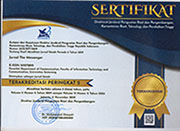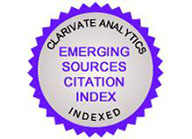Strategic Factors for Building Brand Equity: Jordan Medical Tourism
Abstract
Building a brand with strong equity is a vital element for differentiation and competitiveness, especially in today s highly competitive medical tourism. The literature indicated that Jordan has weak medical tourism brand equity. The contribution of customer relationship management and service quality in developing brand equity can t be ignored. Studies on marketing activities towards building brand equity remain limited. Accordingly, 650 self-administrated questionnaires were distributed to outpatient medical tourists in Amman s five biggest hospitals using systematic sampling. After screening, 454 surveys were used for analysis using structural equation modelling. The results indicated that customer relationship management significantly impacted service quality and brand equity. Service quality strongly influenced brand equity, and brand equity was enhanced indirectly through service quality. This study highlighted the importance of such factors on brand equity-building activities in Jordanian medical tourism context. Further research is recommended to expand the proposed model.
Keywords
Full Text:
PDFReferences
A-Qader, I., Omar, A. B. K., & Rubel, M. R. B. (2017). The influence of affective brand experience dimension on brand equity of the smart phone millennial users in Malaysia. Management, 5(1), 25 37.
Aaker, D. A. (1991). Managing brand equity. New York, NY: The Free Press.
Aaker, D. A. (1996). Building strong brands. New York, NY: The Free Press. Retrieved from https://doi.org/10.2307/41165845
Aaker, D. A., & Joachimsthaler, E. (2000). Brand leadership. New York, NY: The Free Press.
Achmad, F. (2015). The effect of tourism service quality, tourist destination image and experience of tourist towards tourists satisfaction, tourism word of mount, tourist destination preferences, and tourist destination loyalty (a study on foreign tourists in tourist dest. European Journal of Business and Management, 7(2), 95 103.
AÄŸaoÄŸlu, S. (2015). Medical tourism assessment: Case of Izmir. Journal of Hospitality and Management Tourism, 8(4), 1 6.
Akroush, M. N., Dahiyat, S. E., Gharaibeh, H. S., & Abu-Lail, B. N. (2011). Customer relationship management implementation: An investigation of a scale s generalizability and its relationship with business performance in a developing country context. International Journal of Commerce and Management, 21(2), 158 190. Retrieved from https://doi.org/10.1108/10569211111144355
Al-Azzam, F. (2013). Analysis of the antecedents of customer-based brand equity and its application to multiple destinations. Interdisciplinary Journal of Contemporary Research in Business, 5(5), 71 90.
Al Emam, D. (2016). Number of medical tourists drops 30% in Q1 of 2016. Retrieved April 9, 2018, from http://www.jordantimes.com/news/local/number-medical-toursits-drops-30-q1-2016
Aliman, N. K., & Mohamad, W. N. (2013). Perceptions of service quality and behavioral intentions: A mediation effect of patient satisfaction in the private health care in Malaysia. International Journal of Marketing Studies, 5(4), 15 29. Retrieved from https://doi.org/10.5539/ijms.v5n4p15
Alipour, M., & Mohammadi, M. H. (2011). The effect of customer relationship management (CRM) on achieving competitive advantage of manufacturing tractor. Global Journal of Business and Management Research, 11(5), 26 36.
Ang, L., & Buttle, F. (2006). Customer retention management processes: A quantitative study. European Journal of Marketing, 40(1/2), 83 99.
Aprinta, G. E. B., Syamsiah, S., & Hernofika, L. (2017). Social marketing strategy to make students awareness of throwing away garbage on the bin. Jurnal The Messenger, 9(3). Retrieved from https://doi.org/10.26623/themessenger.v9i2.516
Asare, I. T., & Lei, S. (2017). Investigating the effect of selected marketing efforts in brand equity creation and its cross-cultural invariance in emerging markets. International Journal of Marketing Studies, 9(1), 91 108.
Aspizain, C. (2016). The effects of service quality and corporate rebranding on brand image, customer satisfaction, brand equity and customer loyalty: Study in advertising company at tvOne. Russian Journal of Agricultural and Socio-Economic Sciences, 60(12), 118 126.
Awang, Z. (2014). A handbook on SEM for academicians and practitioners: The step by step practical guides for the beginners. Bandar Baru Bangi: MPWS Rich Resources.
Awang, Z. (2015). SEM made simple: A gentle approach to learning structural equation modeling. Selangor, Malaysia: MPWS Rich Publication.
Awang, Z., Afthanorhan, A., & Mamat, M. (2016). The Likert scale analysis using parametric based Structural Equation Modeling (SEM). Computational Methods in Social Sciences, 4(1), 13 21.
Azadi, R., Yousefi, B., & Eydi, H. (2015). The impact of brand country-of-origin image on the formation of brand equity in the sports apparel industry. Universal Journal of Industrial and Business Management, 3(3), 67 73.
Bakshi, M., Bakshi, M., Mishra, P., & Mishra, P. (2017). Drivers of brand equity of television news channels: Evidences from emerging market. Marketing Intelligence and Planning, 35(1), 147 162.
Bani Mustafa, A. (2017). Sector leader blames gov t for 40% decline in medical tourism. Retrieved April 9, 2018, from http://www.jordantimes.com/news/local/sector-leader-blames-gov t-40-decline-medical-tourism
Battor, M., & Battor, M. (2010). The impact of customer relationship management capability on innovation and performance advantages: Testing a mediated model. Journal of Marketing Management, 26(9 10), 842 857. Retrieved from https://doi.org/10.1080/02672570903498843
Bhabha, H. K. (2012). The Location of Culture. Routledge. https://doi.org/10.1080/09700161003659111
Burns, A. C., & Bush, R. F. (2010). Marketing research. Upper Saddle River, N.J: Prentice Hall.
Chahal, H., & Bala, M. (2012). Significant components of service brand equity in healthcare sector. International Journal of Health Care Quality Assurance, 25(4), 343 362.
Chakravarty, A. (2011). Evaluation of service quality of hospital outpatient department services. Medical Journal Armed Forces India, 67(3), 221 224.
Chen, H. C., & Green, R. D. (2011). Brand equity, marketing strategy, and consumer income: A hypermarket study. Journal of Management and Marketing Research, 8(1), 1 18.
Chen, Y. S. (2010). The drivers of green brand equity: Green brand image, green satisfaction, and green trust. Journal of Business Ethics, 93(2), 307 319.
Chomvilailuk, R., & Srisomyong, N. (2016). Three dimensional perceptions of medical/health travelers and destination brand choices: Cases of Thailand. Procedia-Social and Behavioral Sciences, 175, 376 383.
Cronin, Jr, J. J., & Taylor, S. A. (1994). SERVPERF versus SERVQUAL : Reconciling performance-based and perceptions-minus-expectations measurement of service quality. Journal of Marketing, 58(1), 125 131. Retrieved from https://doi.org/10.2307/1252256
Cronin Jr, J. J., & Taylor, S. A. (1992). Measuring service quality: A reexamination and extension. The Journal of Marketing, 56(3), 55 68. Retrieved from https://doi.org/10.2307/1252256
Dalbooh, M. A. A. (2015). Marketing Jordan as a regional medical service center (view point of employee). International Journal of Marketing Studies, 7(3), 107 119.
Das, G., & Mukherjee, S. (2016). A measure of medical tourism destination brand equity. International Journal of Pharmaceutical and Healthcare Marketing, 10(1), 104 128.
Davcik, N. S., da Silva, R. V, & Hair, J. F. (2015). Towards a unified theory of brand equity: Conceptualizations, taxonomy and avenues for future research. Journal of Product and Brand Management, 24(1), 3 17.
Demo, G., Watanabe, E. A. D. M., Chauvet, D. C. V, & Rozzett, K. (2017). Customer relationship management scale for the b2c market: A cross-cultural comparison. RAM. Revista de Administra o Mackenzie, 18(3), 42 69.
Dhurup, M., Mafini, C., & Dumasi, T. (2014). The impact of packaging, price and brand awareness on brand loyalty: Evidence from the paint retailing industry. Acta Commercii, 14(1), 1 9.
Dib, H., & Alhaddad, A. (2014). The hierarchical relationship between brand equity dimensions. European Scientific Journal, 10(28), 183 194.
Fuentes, C. M. (1999). Measuring hospital service quality: A methodological study. Managing service quality. An International Journal, 9(4), 230 240.
Ghahfarokhi, A. D., & Zakaria, M. S. (2009). The impact of CRM on customer retention in Malaysia. In International Conference on Electrical Engineering and Informatics (ICEEI 09 (pp. 309 313). IEEE.
Ha, H. Y. (2009). Effects of two types of service quality on brand equity in China: The moderating roles of satisfaction , brand associations , and brand loyalty. Seoul Journal of Business, 15(2), 59 83.
Hafeez, S., & Abbas, T. (2017). Impact of CRM practices on service quality in the banking industry. Pakistani Administrative Review, 1(2), 130 144.
Hair, J. F., Black, W. C. J., Babin, B. J., Anderson, R. E., & Tatham, R. L. (2010). Multivariate data analyisis (7th ed.). Upper Saddle River, NJ: Pearson Prentice Hall.
Han, H., & Hyun, S. S. (2015). Customer retention in the medical tourism industry: Impact of quality, satisfaction, trust, and price reasonableness. Tourism Management, 46, 20 29.
Hapsari, R., Clemes, M. D., & Dean, D. (2017). The impact of service quality, customer engagement and selected marketing constructs on airline passenger loyalty. International Journal of Quality and Service Sciences, 9(1), 21 40.
Hepola, J., Karjaluoto, H., & Hintikka, A. (2017). The effect of sensory brand experience and involvement on brand equity directly and indirectly through consumer brand engagement. Journal of Product and Brand Management, 26(3), 282 293.
Hirut, S. (2015). The effect of service quality on customer based brand equity (a case of commercial bank of Ethiopia). Dissertation. Ethiopia.
Karunanithy, M., & Sivesan, S. (2013). An empirical study on the promotional mix and brand equity: Mobile service providers. Industrial Engineering Letters, 3(3), 1 9.
Kasim, A., & Minai, B. (2009). Linking CRM strategy, customer performance measures and performance in the hotel industry. International Journal of Economics and Management, 3(2), 297 316.
Keller, K. L. (1993). Conceptualizing, measuring, and managing customer-based brand equity. The Journal of Marketing, 557(1), 1 22. Retrieved from https://doi.org/10.2307/1252054
Keller, K. L. (2013). Strategic brand management: Building, measuring, and managing brand equity. (4th, Ed.). Upper Saddle River, NJ: Pearson Prentice Hall.
Keller, K. L., & Lehmann, D. R. (2006). Brands and branding: Research findings and future priorities. Marketing Science, 25(6), 740 759.
Khalafinezhad, R., & Long, C. S. (2013). Customer satisfaction and loyalty: A review in the perspective of CRM. Sains Humanika, 64(2), 61 66.
Kim, K. H., Kim, K. S., Kim, D. Y., Kim, J. H., & Kang, S. H. (2008). Brand equity in hospital marketing. Journal of Business Research, 61(1), 75 82. Retrieved from https://doi.org/10.1016/j.jbusres.2006.05.010
King, C., & King, C. (2017). Brand management standing out from the crowd: A review and research agenda for hospitality management. International Journal of Contemporary Hospitality Management, 29(1), 115 140.
Lin, R. J., Chen, R. H., & Chiu, K. K. S. (2010). Customer relationship management and innovation capability: An empirical study. Industrial Management and Data Systems, 110(1), 111 133. Retrieved from https://doi.org/10.1108/02635571011008434
Loureiro, S. M. C., & Kaufmann, H. R. (2017). Advertising and country-of-origin images as sources of brand equity and the moderating role of brand typicality. Baltic Journal of Management, 12(2), 153 170.
Loureiro, S. M. C., Loureiro, S. M. C., Kaufmann, H. R., & Kaufmann, H. R. (n.d.). No Title.
Mahfooz, Y. (2015). Brand equity-consequence relationship: Evidence from automobile industry. International Journal of Business and Management, 10(3), 81 90.
Malkwai, K. (2015). Medical tourism generates over JD1 billion in 2014. Retrieved March 25, 2018, from http://www.jordantimes.com/news/local/medical-tourism-generates-over-jd1-billion-2014-
Marinova, S., Cui, J., Shiu, E., & Marinov, M. (2012). Impact of customer relationships on brand equity in Chinese retail banking. Journal of Euromarketing, 21(1), 37 52.
Marinova, S. T., Cui, J., & Marinov, M. A. (2008). Customer relationships and brand equity in China s banking services. Revista de Administracao Faces Journal, 7(3), 11 27.
Ming, T. T., Wei, L. T., Lee, W. S. S., Ong, M. B. F., & Su-Mae, T. (2012). Consumer-based brand equity in the service shop. International Journal of Marketing Studies, 4(4), 60 77.
Mohammed, A. A., & Rashid, B. (2012). Customer relationship management (CRM) in hotel industry: A framework proposal on the relationship among CRM dimensions, marketing capabilities, and hotel performance. International Review of Management and Marketing, 2(4), 220 230.
Molinari, L. K., Abratt, R., & Dion, P. (2008). Satisfaction, quality and value and effects on repurchase and positive word-of-mouth behavioral intentions in a B2B services context. Journal of Services Marketing, 22(5), 363 373. Retrieved from https://doi.org/10.1108/08876040810889139
Mostafa, R. H. (2015). The impact of country of origin and country of manufacture of a brand on overall brand equity. International Journal of Marketing Studies, 7(2), 70 83. Retrieved from https://doi.org/10.5539/ijms.v7n2p70
Mourad, M., Ennew, C., & Kortam, W. (2011). Brand equity in higher education. Marketing Intelligence and Planning, 29(4), 403-420.
Mukherjee, S., & Shivani, S. (2016). Marketing mix influence on service brand equity and its dimensions. Vision: The Journal of Business Perspective, 20(1), 9 23.
Murtiasih, S., Sucherly, S., & Siringoringo, H. (2014). Impact of country of origin and word of mouth on brand equity, 32(5), 616 629.
Nataraj, S. (2010). Customer retention CRM application. Issues in Informations Systems, 11(2), 44 47.
Noor, R. (2013). Outbound medical tourism from Bangladesh: Problems and solutions. University of Greenwich.
Osman, Z., & Sentosa, I. (2013). Influence of customer satisfaction on service quality and trust relationship in Malaysian rural tourism. Business Management Quarterly Review, 4(2), 12 25.
Parasuraman, A., Zeithaml, V. A., & Berry, L. L. (1985). A conceptual model of service quality and its implications for future research. The Journal of Marketing, 49(9), 41 50.
Parasuraman, A., Zeithaml, V. A., & Berry, L. L. (1988). Servqual: A multiple-item scale for measuring consumer perspectives of service quality. Journal of Retailing, 64(1), 12 22.
Rajh, E. (2006). The effects of marketing mix elements on brand equity. Croatian Economic Survey, 14(8), 53 80.
Ramseook-Munhurrun, P., Lukea-Bhiwajee, S. D., & Naidoo, P. (2010). Service quality in the public service. International Journal of Management and Marketing Research, 3(1), 37 50.
Rashid, B. B., & Tahir, S. B. (2013). Assessing the influence of customer relationship management (CRM) dimensions on organization performance: An empirical study in the hotel industry. Journal of Hospitality and Tourism Technology, 4(3), 228 247. Retrieved from https://doi.org/10.1108/JHTT-01-2013-0002.
Rust, R. T., Zahorik, A. J., & Keiningham, T. L. (1995). Return on quality (ROQ): Making service quality financially accountable. The Journal of Marketing, 59(2), 58 70.
Saini, S., & Malik, H. (2014). The impact of customer relationship management on the service quality of the star rated hotels in Jalandhar and Ludhiana. International Journal of Informative and Futuristic Research, 10(1), 174 185. Retrieved from https://doi.org/10.1007/s11002-009-9096-z.
Samadbeik, M., Asadi, H., Mohseni, M., Takbiri, A., Moosavi, A., & Garavand, A. (2017). Designing a medical tourism website: A qualitative study. Iranian Journal of Public Health, 46(2), 249-257.
Sari, A. A. (2018). The akat Politeknik Indonusa Surakarta. Jurnal The Messenger, 10(1), 93. Retrieved from https://doi.org/10.26623/themessenger.v10i1.417
Šerić, M., & Šerić, M. (2017). Relationships between social Web, IMC and overall brand equity: An empirical examination from the cross-cultural perspective. European Journal of Marketing, 51(3), 646 667.
Severi, E., & Ling, K. C. (2013). The mediating effects of brand association, brand loyalty, brand image and perceived quality on brand equity. Asian Social Science, 9(3), 125 137.
Shofiah, S. (2017). Study of influence of customer relationship management on customer satisfaction in CV Batik Semarang. Journal of Marketing Science, 16(1), 57 69.
Shriedeh, F. B., & Abd. Ghani, N. H. (2016). Service quality as an antecedent of brand equity: Empirical evidence in the medical tourism from Jordan. International Review of Management and Marketing, 7(1), 15 19.
Shriedeh, F. B., & Abd. Ghani, N. H. (2018). The role of customer relationship management, service quality and innovation as sources of brand equity development. In Proceedings of the SMMTC Postgraduate Symposium: Advancing Research in Communication, Media and Multimedia: Theory Methodology and Applications (pp. 50 55). Malaysia: Universiti Utara Malaysia.
Shriedeh, F. B., & Ghani, N. H. A. (2017). Impact of innovation on the relationship between customer relationship management and brand equity in the medical tourism of Jordan. Journal of Research in Business, Economics and Management, 7(4), 1150 1158.
Sin, L. Y., Alan, C. B., & Yim, F. H. (2005). CRM: Conceptualization and scale development. European Journal of Marketing, 39(11/12), 1264 1290. Retrieved from https://doi.org/10.1108/03090560510623253
Teas, R. K. (1993). Expectations, performance evaluation, and consumers perceptions of quality. The Journal of Marketing, 57(4), 18 34.
Vatjanasaregagul, L. (2007). The relationship of service quality, consumer decision factors and brand equity. Nova Southeastern University.
Vinh, T. T., Nga, V. T. Q., & Nguyen, N. P. (2017). The causal relationships between components of customer-based brand equity for a destination: Evidence from South Korean tourists in Danang city, Vietnam. In Asian Economic and Financial Review (pp. 358 367). Danang city.
Yoo, B., & Donthu, N. (2002). Testing cross-cultural invariance of the brand equity creation process. Journal of Product and Brand Management, 11(6), 380 398. Retrieved from https://doi.org/10.1016/S0148-2963(99)00098-3
Yoo, B., Donthu, N., & Lee, S. (2000). An examination of selected marketing mix elements and brand equity. Journal of the Academy of Marketing Science, 28(2), 195 211. Retrieved from https://doi.org/10.1177/0092070300282002
Zablah, A. R., Bellenger, D. N., & Johnston, W. J. (2004). An evaluation of divergent perspectives on customer relationship management: Towards a common understanding of an emerging phenomenon. Industrial Marketing Management, 33(6), 475 489. Retrieved from https://doi.org/10.1016/j.indmarman.2004.01.006
Zarantonello, L., & Schmitt, B. H. (2013). The impact of event marketing on brand equity: The mediating roles of brand experience and brand attitude. International Journal of Advertising, 32(2), 255 280.
Zeithaml, V. A., Berry, L. L., & Parasuraman, A. (1996). The behavioral consequences of service quality. The Journal of Marketing, 60(2), 31 46.
Zikmund, W., Babin, B., Carr, J., & Griffin, M. (2009). Business Research methods (8th ed.). Boston, MA: South-Western, Cengage Learning.
DOI: http://dx.doi.org/10.26623/themessenger.v11i1A.821
Refbacks
- There are currently no refbacks.
Copyright (c) 2019 Jurnal The Messenger
View My Stats [Jurnal The Messenger] is an International Scientific Journal, Published by the Department of Communication, Faculty of Information Technology and Communication, Universitas Semarang (Central Java, Indonesia). It is licensed under a Creative Commons Attribution 4.0 International License.



_11.jpg)




_BARCODE.jpg)
_BARCODE1.jpg)



5.png)










2.png)





